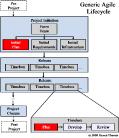Today a new project manager, somebody running one of my work streams, asked to put her risks on my programme risk and issues log. She didn’t really want to but apparently she’d been told to do this by her organisational masters outside the programme. I told her not to. Why? Because I use the log for the programme not the sub-projects. Since I had to explain my thinking to people in the company I thought it warranted a blog entry.
Continue reading
Tag Archives: risk management
Build it in a Week
I ran a massed prototyping exercise with my current team. The whole team: development, user experience and design, testing, product management, business analysis, programme/project management and the programme director. It was a concerted effort to get a solution covering everything. The idea was to build wide not deep. The requirements for the end to end workflow was a generic operating model we’d developed previously. Microsoft Sharepoint was the underlying platform so this exercise concentrated on “out-of-the-box” solutions based on Sharepoint.
Expected Benefits
I allocated a week for this so the cost was quite high. On the other hand I expected considerable benefits. I expected “Build it in a Week” to enable us to:
- understand the requirements more
- validate the generic operating model
- validate the emerging information architecture
- identify technical challenges and identify if “tricky” things were in fact simple
- demo an end to end solution (even if clunky and with caveats)
- understand Sharepoint 2010 more, specifically understand what “out-of-the-box” means in 2010
- identify what we can’t do “out-of-the-box” right now
- understand each other more
As programme manager I thought it worth the cost.
Continue reading
Agile Project Monitoring and Control
No battle plan survives contact with the enemy
Field Marshal Helmuth Graf von Moltke
Life is what happens to you
while you’re busy making other plans
John Lennon
Agile Project Planning tells us what we expect to do, but, to paraphrase the quotes above, plans often turn to custard. The job of the Agile Project Manager is to guide the team to successful delivery despite the challenges the world throws at the project. This article is about monitoring the project against the plan and intervening when we notice things going off track. In particular it covers Traditional Project Monitoring & Control, Agile versus Traditional Monitoring & Control, Agile Project control, Agile project metrics, Agile Project Reporting, and Agile Project Monitoring.
Continue reading
Agile Project Planning
No battle plan survives contact with the enemy
Plans are nothing, but planning is everything
Field Marshal Helmuth Graf von Moltke
 I believe that Agile Project Management provides certainty of delivery. Planning is what lets us answer the question “When will you be finished?”. Planning is, however, just the start of the process. As Moltke pointed out planning is more important that the plan because once you start the project you’ll find the plan is wrong and you have to adapt. All plans need revisiting and you will have to use Agile Project Control, Agile Change Management, and Agile Risk Management to get the promised certainty of delivery.
I believe that Agile Project Management provides certainty of delivery. Planning is what lets us answer the question “When will you be finished?”. Planning is, however, just the start of the process. As Moltke pointed out planning is more important that the plan because once you start the project you’ll find the plan is wrong and you have to adapt. All plans need revisiting and you will have to use Agile Project Control, Agile Change Management, and Agile Risk Management to get the promised certainty of delivery.
Continue reading
Agile Project Initiation
One company I worked with called the start of the project the “Blueprint” as it is about roughly shaping the project and product. “Inception” is another common term for this phase in agile projects. This article outlines traditional project initiation then delves into more detail on Agile Project Initiation.
Continue reading
Agile Risk Management
Risk management is about identifying, addressing, and eliminating sources of risk before they become a threat to the project. This article outlines traditional risk management, how Agile is a risk mitigation strategy, and how to do Agile risk management.
Continue reading